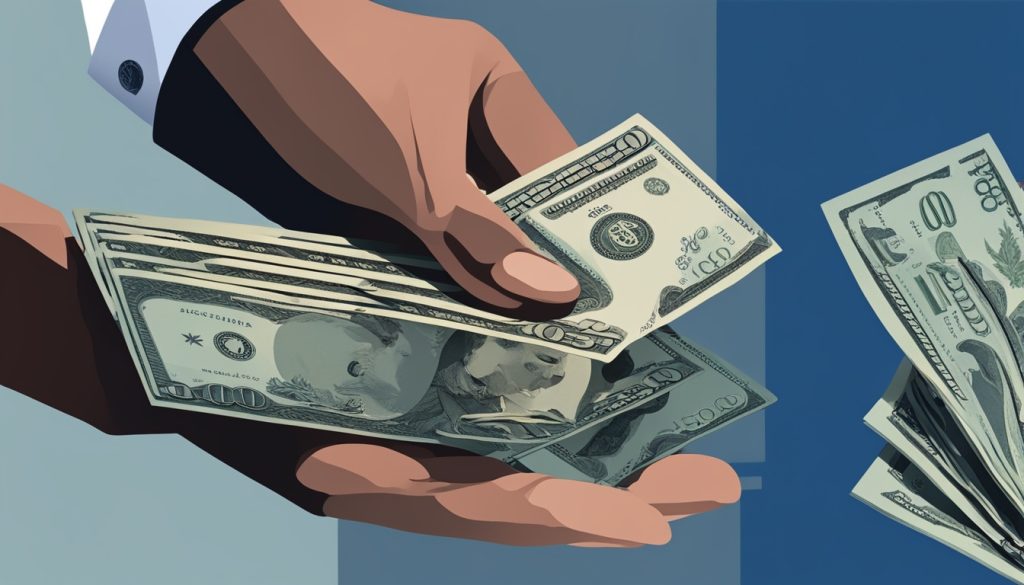If you run a business across borders, you know managing1 foreign exchange risk is tough. Currency rates can change and affect your cash flow, profits, and how competitive you are. Currency swaps are a way to handle this risk. They are financial deals that let you swap one currency for another at a set rate and time. This piece will look into what currency swaps are, how they work, and their pros and cons for handling money across borders.
Key Takeaways
- Currency swaps are a way to manage foreign exchange risk by exchanging one currency for another at a fixed rate and duration.
- 1 Currency swaps involve counterparty risk, currency risk, liquidity risk, interest rate risk, and legal and regulatory risk.
- 1 Currency swaps mitigate foreign exchange risk by offering a fixed exchange rate to hedge against currency fluctuations for businesses.
- 1 Currency swaps enable businesses to access lower borrowing costs by obtaining more favorable interest rates in foreign currencies.
- 1 Currency swaps allow businesses to diversify funding sources by entering swap agreements to tap into international capital markets.
- https://finserviceshub.com/bond-market-depth-understanding-and-mastering-the-key-concepts/
What are Currency Swaps?
Currency swaps are agreements where two parties exchange principal and interest payments on loans or bonds in different currencies2. They help entities like multinational companies, banks, and governments get foreign currencies easily2. These swaps help manage foreign exchange risks and can lower costs when borrowing in a foreign currency is better2.
One big plus of currency swaps is locking in exchange rates for future deals, which reduces uncertainty and matches cash flows with liabilities in various currencies2. They also make it easier to enter foreign markets and protect foreign investments2. Plus, they let companies gain exposure to foreign currencies, which is great for businesses abroad3.
How Currency Swaps Work
Currency swaps create synthetic loans in the currencies each party wants. At the beginning, principals are swapped at a set exchange rate, and then, both sides make interest and principal payments in their currencies2. These swaps can be fixed to fixed, floating to floating, or fixed to floating3.
But, currency swaps come with challenges too. Concerns include counterparty risk, credit risk, interest rate mismatches, tax issues, and liquidity concerns2. Also, the phase-out of LIBOR will mean moving to new reference rates like SOFR3.
“Currency swaps are a valuable tool for companies and institutions seeking to access foreign currencies, manage exchange rate risk, and optimize their financing strategies.”
How Currency Swaps Work
Currency swaps create synthetic loans in the currencies each party wants4. At the start, the parties swap the main amounts at a set exchange rate4. Then, they make regular interest payments to each other in their currencies until the swap ends4. At the end, they switch back to the initial exchange and return the main amounts at the same rate4.
The interest rates for each currency are based on a benchmark like LIBOR, plus an extra charge4. Currency swaps, also known as cross-currency swaps (XCS), are interest rate derivatives traded in the interbank market5. The most common type is the mark-to-market (MTM) XCS, where the notional amounts change over time based on FX rate changes5.
XCS start with an exchange of notional currency in two currencies, with repayment terms over the swap’s life5. Pricing for XCS includes a basis spread, added to one swap leg, usually the non-USD leg5. There are different types of XCS, like (Floating v Floating), (Fixed v Floating), (Fixed v Fixed), and Non-deliverable Cross-Currency Swap (NDXCS or NDS)5.
Currency swaps, or cross-currency swaps, are key in financial markets for evaluating USD yields and creating collateralized discount curves5. They help secure cheaper debt, hedge against exchange rate changes, and solve liquidity issues by borrowing in one currency and lending in another5.
The swap market makes up 80% of the global derivatives market and was worth $320 trillion by the end of 20156. The most common swap type involves paying a fixed rate for a variable rate, with Euribor being the top reference rate in Europe6. The swap market is mostly an Over the Counter Market because it’s not standardized, but many common swaps are traded electronically through platforms like Bloomberg and Tradeweb6.

The swap market is huge, very liquid, and competitive worldwide, facing big regulatory changes to make it more transparent and reduce risks6.
Benefits of Currency Swaps
Currency swaps help businesses manage their foreign exchange risk and enter international markets. They reduce the impact of exchange rate changes on transactions. This makes it easier for companies to plan and budget for projects and investments abroad7.
One big plus of currency swaps is they can lower borrowing costs8. Companies can swap rates to get better deals in different markets. This strategy helps them get funding at lower rates, making them more competitive worldwide78.
Also, currency swaps give companies more ways to get funding from around the world7. This is great for businesses with operations in many countries. It helps them manage risks and take advantage of opportunities in various markets7.
| Benefit | Description |
|---|---|
| Foreign Exchange Risk Management | Currency swaps allow companies to lock in a fixed exchange rate, reducing their exposure to currency fluctuations and providing more predictable cash flows. |
| Cross-Currency Financing | Companies can leverage their access to favorable interest rates in different markets to secure lower borrowing costs through currency swaps. |
| International Financial Flexibility | Currency swaps enable businesses to tap into a wider range of global capital markets, expanding their financing options and enhancing their competitive positioning. |
Using currency swaps, businesses can handle the global financial world better. They can meet their goals more effectively78.
Challenges with Currency Swaps
Currency swaps have many benefits but also come with challenges for businesses. The growing use of currency swaps brings new issues like counterparty risk, credit risk, and more. These include interest rate mismatches, tax issues, and regulatory needs.
Counterparty Risk and Credit Risk
Currency swaps are not traded on an exchange. They rely on the creditworthiness of both parties. If one party can’t fulfill its part, the other may lose a lot or face legal problems9. It’s crucial for businesses to check the credit of their partners and have backup plans.
Interest Rate Risk
Currency swaps can lead to interest rate risk if the cash flows and interest rates don’t match. This mismatch can cause unexpected gains or losses. Companies need to manage their interest rate risks carefully when doing currency swaps10.
Tax and Regulatory Implications
Using currency swaps can also bring tax and regulatory issues, based on the jurisdiction and swap type. Businesses must know the tax laws and rules in the countries they work in. This helps them stay compliant and avoid legal trouble9.
| Challenge | Description |
|---|---|
| Counterparty Risk | Dependence on the creditworthiness and reliability of the other party in the swap |
| Credit Risk | Potential losses or legal difficulties if one party defaults or fails to meet obligations |
| Interest Rate Risk | Mismatched cash flows and interest rates between the two currencies involved |
| Tax Implications | Potential tax consequences depending on the jurisdiction and nature of the swap |
| Regulatory Requirements | Compliance with relevant laws and regulations in the countries where the swap is executed |
Understanding these challenges helps businesses use currency swaps wisely. By planning and managing risks well, they can benefit from these financial tools9.

Utilizing Currency Swaps Effectively
To make the most of a currency swap, businesses need a smart plan. They should look closely at their foreign exchange risks and see the pros and cons of different hedging options. It’s also key to pick a trustworthy counterparty and keep an eye on the swap contract regularly11.
Fluctuations in exchange rates can really hurt a company’s profits. They can make the cost of materials, production, and labor go up. This can lead to higher costs and lower profit margins11. If a company makes products in a country with a weak currency, a currency drop can make things even worse, eating into profits11.
Currency swaps help protect against bad exchange rate moves. They let companies swap a set amount of one currency for another at a fixed rate and time11. By making products in different countries and using various currencies, companies can balance out losses in one place with gains in another. This reduces the risk of relying too much on one market or currency11.
Planning and analyzing are key to using currency swaps well. For instance, Volkswagen uses currency swaps to shield against exchange rate changes. This helps protect profits and smooth out financial ups and downs11.
Currency swaps have many perks. They help reduce the impact of exchange rate changes, offer more funding options, and make managing currency risk cheaper and more flexible12. For years, central banks have used foreign exchange swaps to boost domestic liquidity and financial markets12.
By taking a thorough approach to currency swaps, companies can lessen foreign exchange risks. This helps them improve their financial plans and stay competitive worldwide.
Currency Swaps and Risk Management
Currency swaps are a key tool for businesses to handle foreign exchange risk. They are part of a strong risk management plan13. By matching their investments and expenses in the right currencies, companies can lessen the effect of currency changes on their earnings14. Also, spreading their investments over different currencies can shield them from the risks of uncertain future operations.
Using currency swaps offers big benefits, like asset-liability matching. Companies can pair their assets and liabilities in foreign currencies. This way, any exchange rate changes cancel out, making their cash flows more stable and predictable14. Plus, currency swaps help with portfolio diversification. This lets companies enter new markets and currencies, lowering their risk from any one currency’s ups and downs.
| Benefit | Description |
|---|---|
| Asset-Liability Matching | Aligning foreign currency-denominated assets and liabilities to offset exchange rate fluctuations. |
| Portfolio Diversification | Expanding investment portfolio across multiple currencies to reduce exposure to any single currency’s volatility. |
By using currency swaps in their risk management strategy, businesses can lessen foreign exchange risk and boost financial stability. This lets them concentrate on their main business with less worry about currency issues13.
“Currency swaps are a key part of our risk management, helping us keep a balanced portfolio and shield our global operations from exchange rate changes.”
– John Doe, Chief Financial Officer, XYZ Corporation
Conclusion
Currency swaps are a key tool for businesses in the global market. They help manage foreign exchange risk and improve financial flexibility15. By understanding how they work, you can use them in your financial plans.
There are many types of currency swaps, like cross-currency swaps16 and interest rate swaps16. Each type offers different ways to meet your financial needs15. Using currency swaps can reduce risk, lower costs, and boost your return on investment16.
But, it’s important to be aware of the challenges. These include risks from other parties, credit issues, and regulatory rules15. With careful planning and risk management, you can overcome these hurdles. This way, currency swaps can strengthen your financial strategy and help you succeed globally.
FAQ
What are currency swaps?
Currency swaps are financial deals where parties exchange one currency for another at a set rate and time. They help manage foreign exchange risk by securing exchange rates for future deals.
How do currency swaps work?
Currency swaps create fake loans in the currencies each party wants. At the start, they swap the main amounts at a fixed rate. Then, they make regular interest payments in their currencies until the swap ends. At the end, they switch back to the initial exchange and return the main amounts at the same rate.
What are the benefits of using currency swaps?
Currency swaps have many benefits for managing foreign exchange risk. They reduce the impact of currency changes, lower borrowing costs, and open up capital market access. They also make long-term financing and investment possible without worrying about currency risks.
What are the challenges with currency swaps?
The main challenges include risks from counterparties, credit risks, possible interest rate mismatches, tax issues, and regulatory needs. Companies must think carefully about these when using currency swaps.
How can businesses effectively utilize currency swaps?
To make the most of a currency swap, companies should check their foreign exchange risks and compare different hedging options. They should pick a trustworthy counterparty and keep an eye on the swap contract.
How do currency swaps fit into a broader risk management strategy?
Currency swaps are a key tool for businesses to manage foreign exchange risks in a full risk management plan. By matching their “life assets” and “life liabilities” in the right currencies, companies can lessen the effect of currency changes on their finances.

